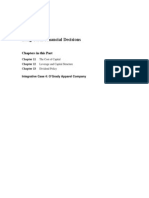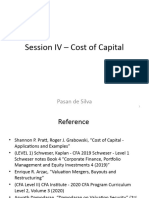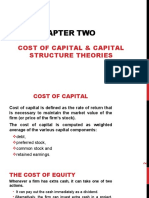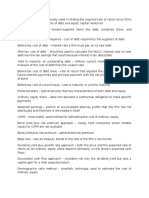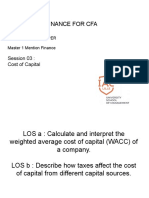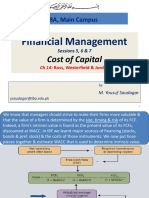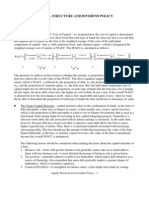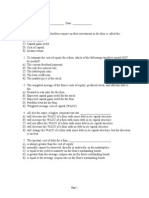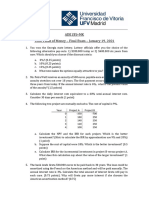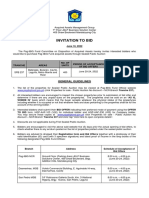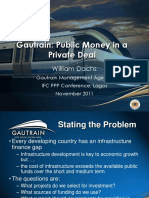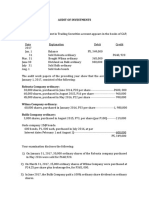GB-530: Corporate Finance
Week 7 Easy Assignment 5
1. Define the following terms:
a. Target Capital Structure - Target capital structure is the ideal mix of debt and equity a company aims
for in financing operations and investments to maximize shareholder value. It is determined by factors
like cost, risk tolerance, and strategy, it also ensures a balance that minimizes capital costs while
maintaining financial flexibility. The components include debt, equity, and sometimes preferred stock.
Because deviation may lead to higher costs, companies often adjust over time based on business changes
and strategic goals.
b. Weighted Average Cost of Capital- The Weighted Average Cost of Capital (WACC) is a crucial
concept in finance, representing a firm's average cost of capital considering various financing sources.
Essential for finance careers, it's often used as a discount rate in Discounted Cash Flow (DCF) analysis to
determine the Net Present Value (NPV) of investments, reflecting the time value of money and investment
risk. Companies use WACC as a benchmark to evaluate projects or investments, signifying the return
needed to compensate bondholders and shareholders. Considering WACC is vital, as lower returns may
pose challenges in raising capital for future projects. There are some limitations which include holding
constant factors like capital structure and interest rates, which may change during an investment.
Additionally, varying formulas for calculation make it subjective, complicating risk assessment.
c. Divisional Cost of Capital- The divisional cost of capital is crucial as it delves into the unique
financial dynamics of a specific division within a company. In big organizations with diverse segments,
each unit has distinct financial characteristics and capital needs. By looking at the cost of capital at the
divisional level, we gain a more detailed understanding, allowing for personalized investment decisions
tailored to each segment's requirements. This involves considering factors like debt costs, equity costs,
and other financial metrics specific to the division. The goal is to calculate a divisional cost of capital that
genuinely reflects the financial intricacies, supporting informed decision-making at the business unit
level.
d. Stand-Alone Risk- Standalone risk focuses on the specific risks associated with a single unit, division,
or asset within a company, analyzed independently rather than as part of a diversified portfolio. Unlike
portfolio risk, which considers all investments, standalone risk calculates risks assuming the specific asset
�is the only investment. It highlights the dangers linked to a particular asset, division, or project, providing
insights into the isolated risks of a company's operations, or holding a specific asset. In project evaluation,
understanding standalone risk helps assess a project's risk independently. In portfolio management, it
gauges the risk of an individual asset not reducible through diversification. Analyzing standalone risk
allows investors to anticipate returns, acknowledging the potential for significant gains or losses with
limited assets.
2. XY Incorporated’s currently outstanding 11% coupon bonds have a yield of maturity of
8.4%. The company believes it could issue new bonds at par that would provide a similar
yield to maturity. If its marginal tax rate is 25%. What is XY’s after-tax cost of debt?
The bond's yield to maturity refers to the rate of return earned by holding bonds until maturity. The yield
and the bond value have an inverse relationship, in which the value of bond will fall as the yield increases
unfortunately.
Summary:
Existing bonds: Yield at 8.4%, coupon rate of 11%
New bonds: Yield at 8.4%, coupon rate of 8.4%
Marginal tax rate = 25%
Determine the after-tax cost of debt:
After-tax cost of debt = Pre-tax cost of debt x (1 - Tax rate)
After-tax cost of debt = 8.4% x (1 - 25%)
After-tax cost of debt = 6.3%
3. Suppose a firm estimates its overall cost of capital for the coming year to be 10%. What
might be reasonable costs of capital for average risk, high-risk, and low-risk projects?
To determine reasonable costs of capital for average, high and low risk projects the firm should develop
risk-adjusted costs of capital for each category of risk based on the concept of divisional WACC. If a firm
estimates that its cost of capital for the coming year will be 10%, the firm should use 10% as the basis for
its average risk projects since the firm will need to achieve a minimum of a 10% return on all its projects.
Typically, a high-risk project has the potential for higher returns and a low-risk project will typically yield
lower returns. Therefore, the firm could set the cost of capital for its high-risk projects at 12% and the
cost of capital for low-risk projects at 8%. Since the average risk project has a 10% cost of capital, the
overall risk of the firms’ projects will be equal to the 10% cost of capital. Similarly, if the firm's high-risk
projects are particularly risky, they could be set at a 15% cost of capital and the low-risk projects will be
adjusted down to a 5% cost of capital. The goal is that the portfolio of the firm's projects will achieve the
required 10% return or greater so that the cost of capital to fund the projects is covered. The assignment
of risk is somewhat subjective, but it is better than not adjusting the risk at all.
4. David Ortiz Motors has a target capital structure of 40% debt and 60% equity. The yield
�to maturity on the company’s outstanding bonds is 9%, and the company’s tax rate is
25%. Ortiz’s CFO has calculated the company’s WACC is 9.9%. What is the company’s
cost of equity capital?
WACC=wd Kd(1−T) +We Ke
0.099 = 0.4* 0.09 (1-0.25) + 0.6* Ke
0.099 = 0.036 (0.75) + 0.6Ke
0.099= 0.027 + 0.6Ke
Ke= 0.072/0.6
Ke= 12%
Weight of debt (WD)= 40%
Weight of equity (We) = 60%
Cost of debt (kd)= 9%
Tax rate = 25%
WACC = 9.9%
Cost of capital equity (Ke) =12%

